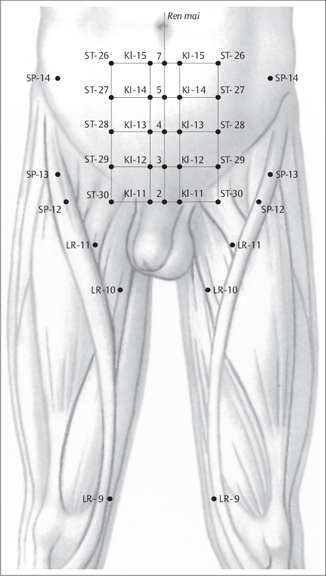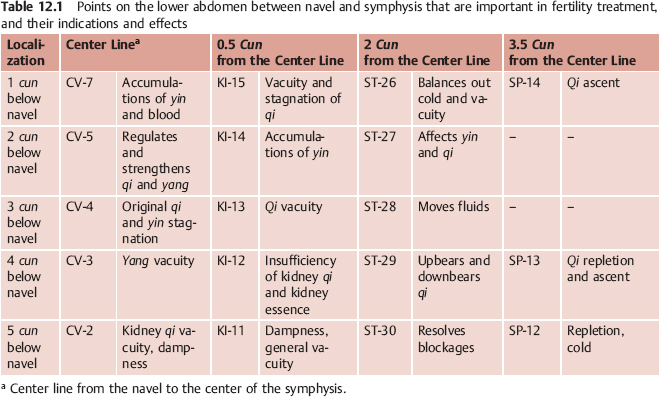12 Acupuncture From the perspective of TCM, the numerous functional—and, in the course of time, occasionally also substantial—disorders of reproductivity and sexuality are disturbances in the area of circulation and the production of qi and blood. After a decisive diagnosis especially of the affected channels (also in the sense of main, luo, muscle, and extraordinary channels), we can then regulate the distribution of qi by means of the channel system. We commonly use acupuncture points that experience has shown to be very effective, such as: These are so-called “qi holes” that have proven extremely effective in the treatment of many andrological and gynecological problems with acupuncture and moxibustion. This chapter deals with unusual, less familiar options in acupuncture and moxibustion therapy. Especially in the lower abdomen and on the liver channel below the lumbar area, there are quite a few points that have an outstanding effect in fertility disorders. This effect depends on the specific combination with other points on the same or a connected channel. The focus of this chapter lies in the description of the effects found in classical Chinese sources of acupuncture. In this context, we discuss points that are less familiar in standard clinical practice (Figs. 12.1). The following points are located on top of or next to the center line (i. e., the median line that runs from the navel to the center of the symphysis), and then 1 to several cun each below the navel (Table 12.1). The points on the pubic line 5 cun below the navel include the following (Table 12.1): Here, the liver channel crosses the ren mai. As the sea of yin, this point is particularly important for the reconstruction of yin (and blood) in the first part of the menstrual cycle. We use this point especially when we find a stagnation of fluid (e. g., cysts, discharge, gummed-up fallopian tubes). In addition, the ren mai functions as the reservoir for essence. Thus, when states of exhaustion arise after pregnancy, miscarriage, or hormone therapy, treating this point can help by strengthening essence and qi. Suitable combinations are, for example, with: The kidney channel and chong mai meet at this point; hence we find these key indications: general exhaustion after having spent all essence—this can be refilled to a certain extent by opening the chong mai—and impaired kidney and bladder functions. Suitable combinations are, for example, with: At this point, the chong mai (“sea of blood”) joins the stomach channel; this is therefore an excellent point for influencing blood, jing, and, via the stomach channel, also postnatal qi. Furthermore, because the chong mai is the “sea of the 12 channels,” we can resolve obstructions and blockages in the entire abdomen here. Suitable combinations are, for example, with: The “thoroughfare” mentioned in the point name here is also the chong mai, which can be reached at the adjoining point qi chong (ST-30). Since the liver channel and spleen channel intersect here as well, we can effectively resolve all kinds of stagnation with this point. Hence, it guarantees access to the thoroughfare of blood (chong mai). Suitable combinations are, for example, with: The points on the line 4 cun below the navel include the following (Table 12.2): CV-3 is an extremely important point since all yin channels of the leg intersect here with ren mai, which is known as the “sea of yin.” Hence, its range of indications includes any energetic state that is characterized by the accumulation of yin (especially cold and fluids). Yang is vacuous; the lower abdomen feels cold and swollen. Especially in women with yang vacuity and infertility, applying moxibustion on this point can help. __________ * This point is also translated as “Surging Gate” in English. Suitable combinations are, for example, with: Here we are obviously dealing with a point that is so important that the early Chinese masters of acupuncture felt compelled to capture this in its name! This is where the kidney channel meets with chong mai—hence, we can strengthen essence and its mobilization through this point: indications are impotence and tendency to miscarriages. Suitable combinations are, for example, with: This passionate exclamation is directed at the failure of qi and yang, which can lead to sagging of the uterus and inability to raise the penis, but also to failed descent of the testicles from the abdomen. Cold and weakness impede qi, especially in the first phase of the menstrual cycle. It is therefore preferable to treat this point with moxibustion. Suitable combinations are, for example, with: This point is characterized by its usefulness in states of repletion with simultaneous qi ascent. As the jiao hui (intersection) point of the spleen, liver, and yin linking channels, it resolves blockages, as a result of which the qi that is ascending counterflow is able to reach the lower burner. The term “abode” in the name of the point furthermore indicates that we can resolve accumulations here; not only material ones but also mental “accumulations”—when the carousel of thoughts will not stop or when you are unable—for example, during sexual intercourse—to pay attention to other people because you are too preoccupied with yourself. Suitable combinations are, for example, with:
Andreas A. Noll
Points on the Pubic Line 5 Cun below the Navel
CV-2: Qu Gu—Curved Bone
Indications from the Zhen Jiu Da Cheng (
 Great Compendium of Acupuncture and Moxibustion)12
Great Compendium of Acupuncture and Moxibustion)12

Combinations
KI-11: Heng Gu—Transverse Bone
Indications from the Zhen Jiu Da Cheng
Combinations
ST-30: Qi Chong—Qi Thoroughfare
Indications from the Zhen Jiu Da Cheng
Combinations
SP-12: Chong Men—Thoroughfare Gate*
Indications from the Zhen Jiu Da Cheng
Combinations
Points on the Line 4 Cun below the Navel
CV-3: Zhong Ji—Central Pole
Indications from the Zhen Jiu Da Cheng
Combinations
KI-12: Da He—Great Manifestation
Indications from the Zhen Jiu Da Cheng
Indications from the Qian Jin Yi Fang (
 Supplemental Prescriptions Worth a Thousand in Gold)11
Supplemental Prescriptions Worth a Thousand in Gold)11
Combinations
ST-29: Gui Lai—Return!
Indications from the Zhen Jiu Da Cheng
Combinations
SP-13: Fu She—Bowel Abode
Indications from the Zhen Jiu Da Cheng
Combinations

![]()
Stay updated, free articles. Join our Telegram channel

Full access? Get Clinical Tree





